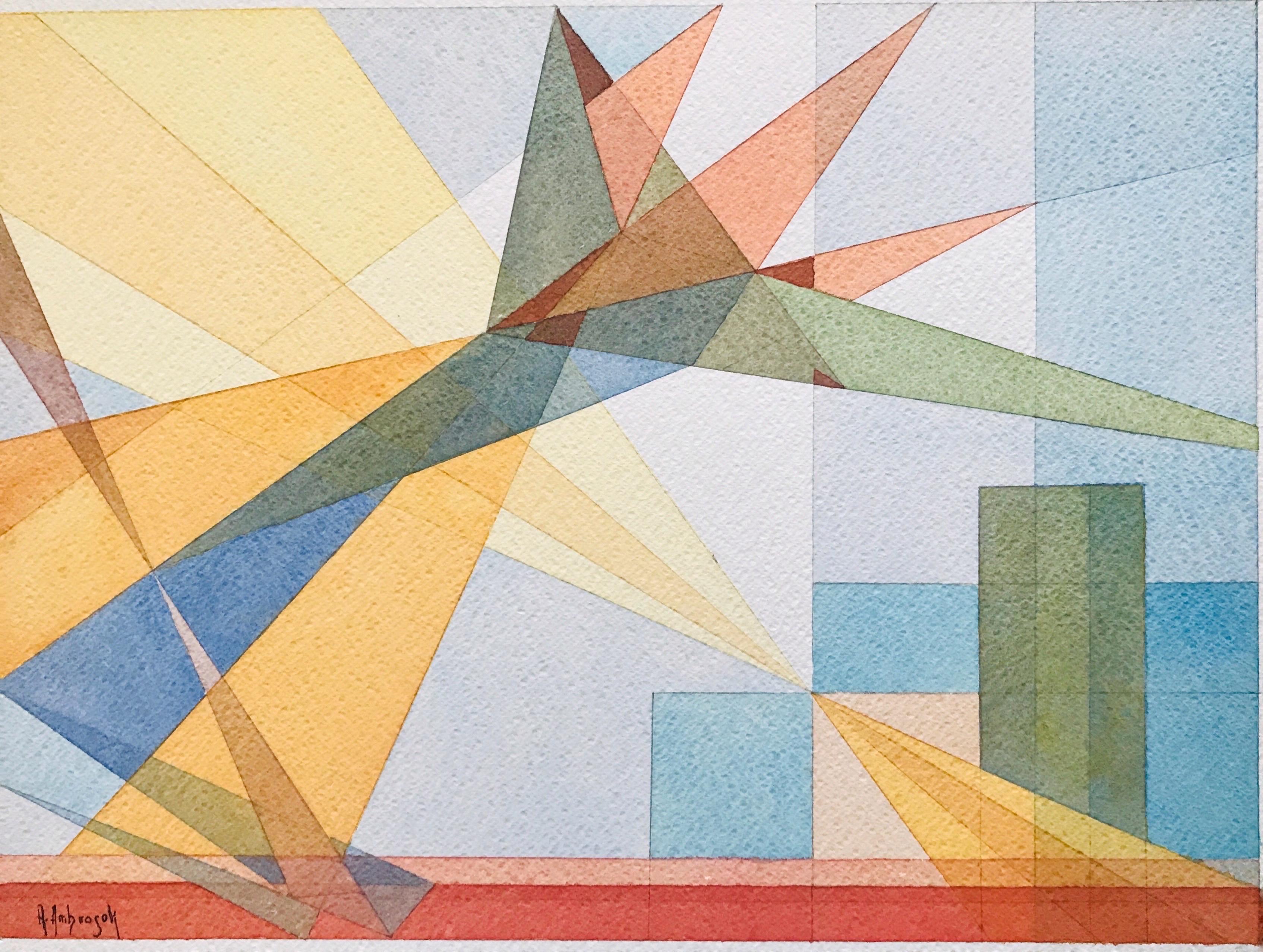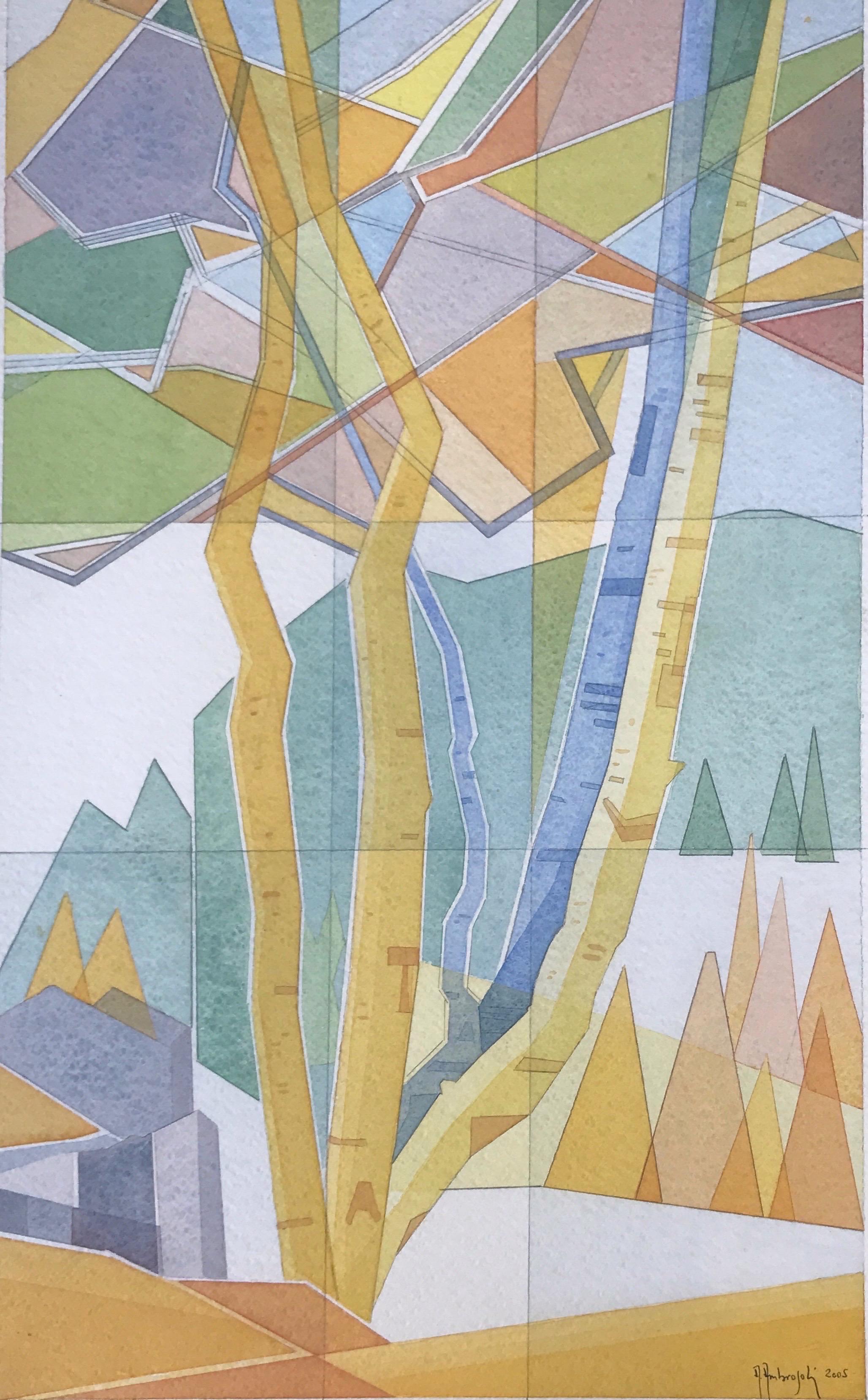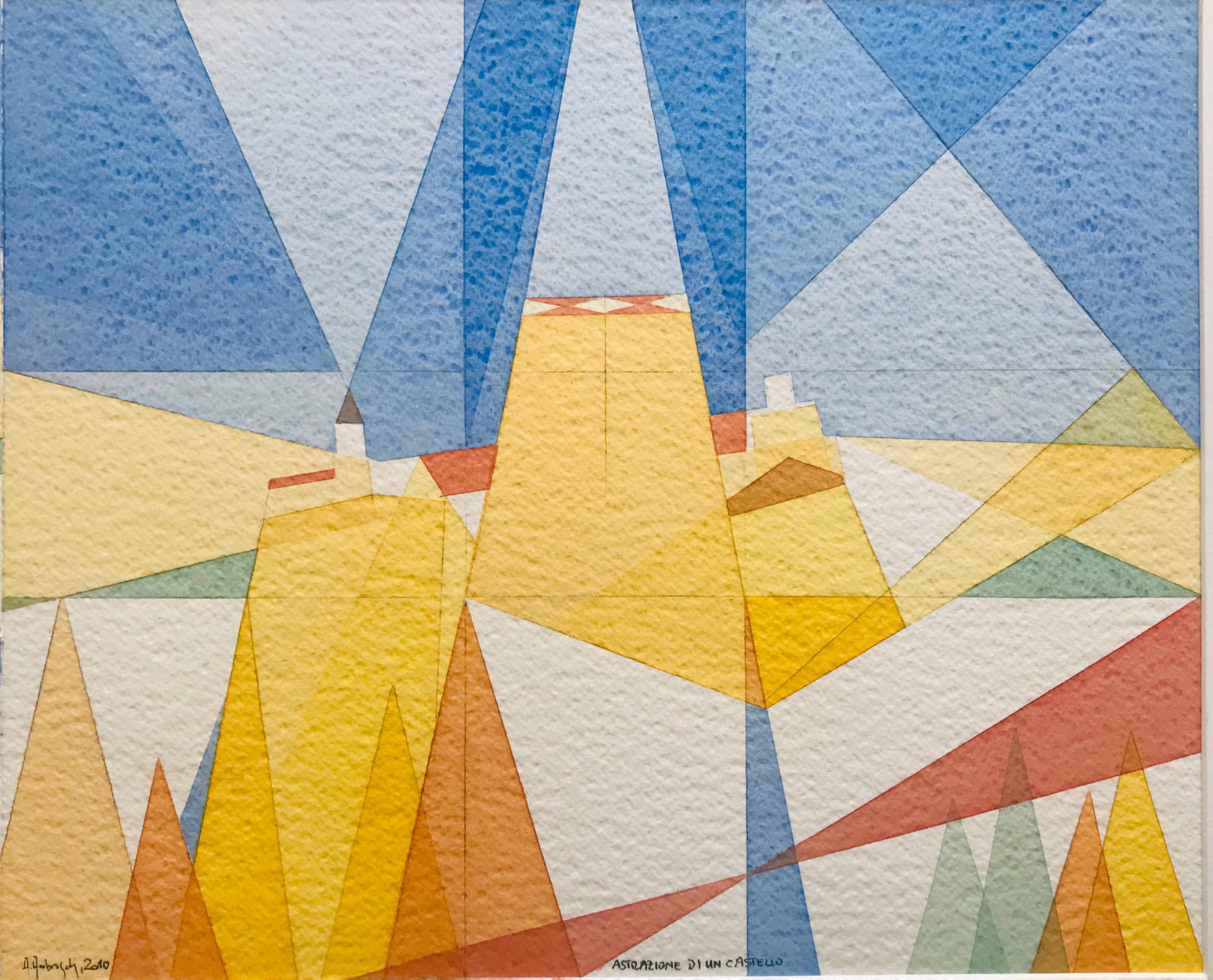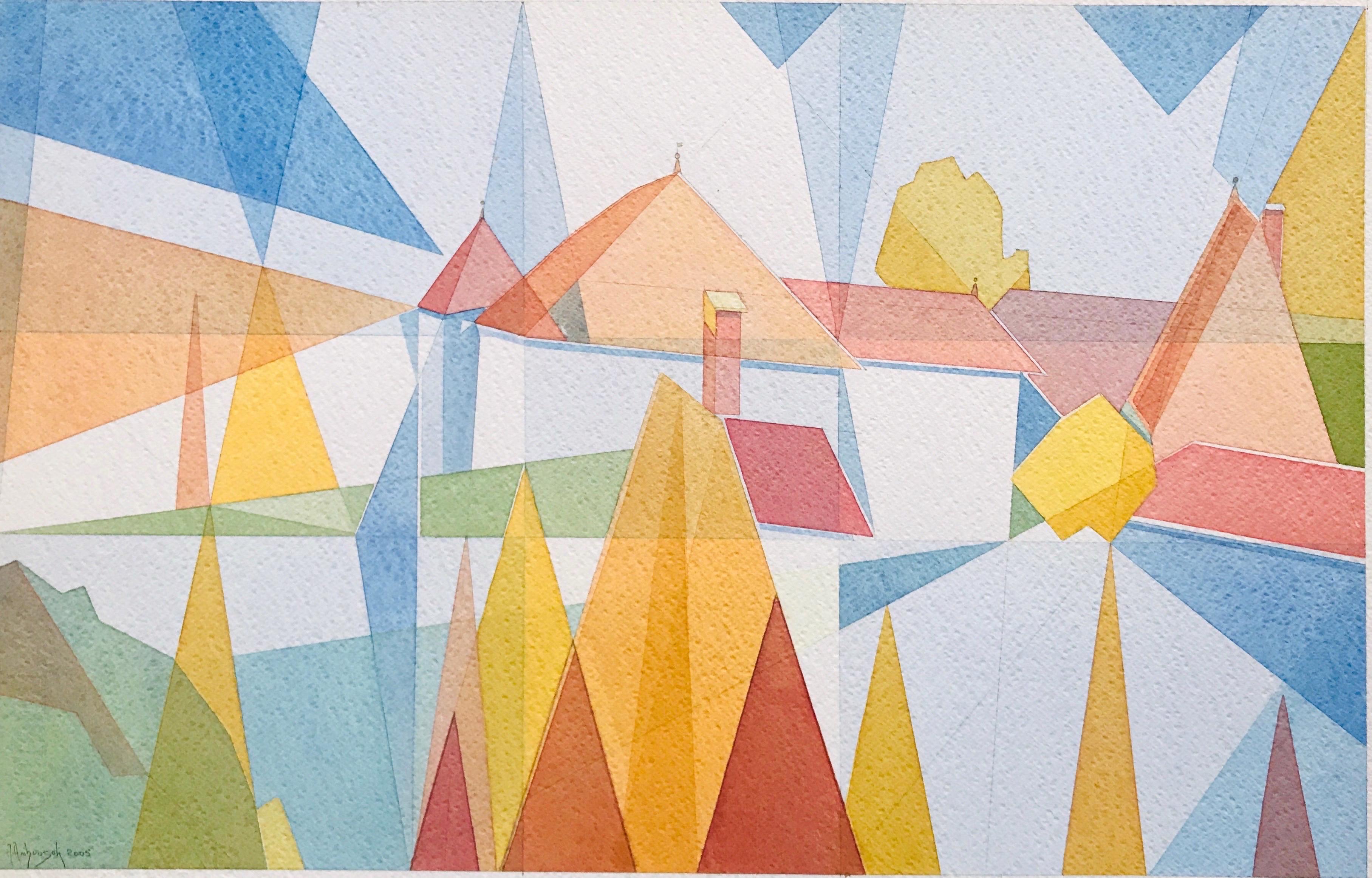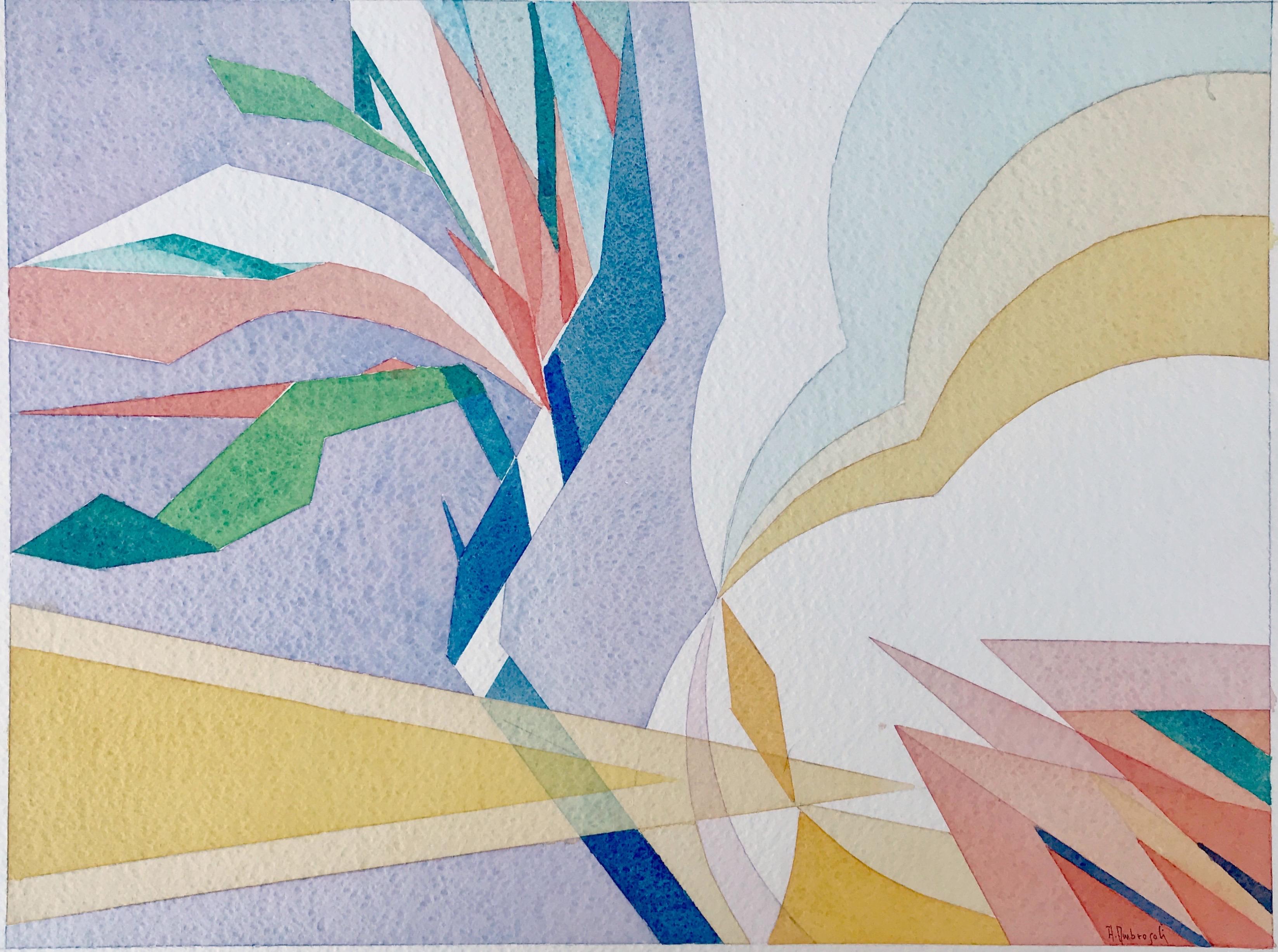Items Similar to Kenneth Rowntree: 'Abstract Australian Landscape' watercolour Modern British Art
Want more images or videos?
Request additional images or videos from the seller
1 of 6
Kenneth RowntreeKenneth Rowntree: 'Abstract Australian Landscape' watercolour Modern British Art1985
1985
About the Item
Kenneth Rowntree
Abstract Australian Landscape
Watercolour
27.5 x 33cm
Signed (top left) and dated ‘Kenneth Rowntree ’85’
Provenance: Anderson & Garland Studio sale of Kenneth Rowntree lot 263 Tuesday 8 September 2009
For biographical details and other works by Rowntree click here.
Rowntree visited Australia in 1984/85. In this painting he picks up various vignettes from the Australian landscape in six separate blocks. Two relate to the sky, with almost-unbroken blue skies stretching from horizon to horizon, three relate to desert areas, with a whole array of different textures, and one is a luscious green. In one of the desert scenes he has picked out two road signs, in typical Rowntree fashion, reducing them to their simplest form. In her essay Kenneth Rowntree: A Strange Simplicity (published in Kenneth Rowntree A Centenary Exhibition Published by Moore-Gwyn Fine Art and Liss Llewellyn Fine Art, on behalf of the artist’s estate, on the occasion of the centenary of Kenneth Rowntree’s birth) Alexandra Harris makes reference to this painting noting:
"Later, in 1986, just when the young David Hockney was collaging the signs and road-markings of Route 138 in Pearblossom Highway, Rowntree was in Australia painting yellow diamond-shaped road-signs as bright icons in open country. Wherever he went, Rowntree captured both the unfamiliarity of places and their relationship to things he knew. Heading into the Australian outback, he painted a road-sign as he would paint a rail signal at Clare in Suffolk or nautical markers at Swansea."
Hockney’s 1986 Pearblossom Highway may be seen in the Getty and it is worth noting that Rowntree was in fact painting the yellow sign in 1985, so a year before Hockney.
Kenneth Rowntree (1915-1997)
Rowntree was born in Scarborough and educated in York where his father managed the local department store. Young Kenneth’s work was displayed there and his first major commission arose from an advertisement at the store. After the Ruskin School of Drawing in Oxford he studied at the Slade School, meeting Eric Ravilious and Edward Bawden and then moving to north Essex to work with them as members of the group of Great Bardfield Artists.
Between 1940 and 1943 he was one of the team of over 60 artists engaged by the War Artists Advisory Committee for the ‘Recording Britain’ project, to record the face of England and Wales before wartime action – or development – changed it for ever. Rowntree’s keen sense of design, and fascination with the quirky and the vernacular made him an ideal candidate to interpret our built heritage’s more unusual aspects.
In 1951 he painted murals in the Lion and Unicorn pavilion for the Festival of Britain, he decorated the route of the Queen’s Coronation procession (some of the works being acquired by Her Majesty).
During a teaching job at the Ruskin School of Drawing in Oxford he was driven, perhaps by his experiences recording Britain, to record the decorated barges that belonged to the Oxford Colleges. These wooden Victorian ceremonial barges had belonged to the London livery companies, but were acquired in their later life by the Colleges to be used as changing rooms and clubhouses for the College boat clubs – depending on the size of the barge rowing eights were stored on board too. Part way through painting one of them Rowntree thought his drawing incorrect until he realised that it was the boat that was moving. It was in fact sinking. These days the Colleges have modern (but unromantic) boat houses; a handful of the barges remain – restored – in private hands.
In 1959 he was appointed Professor of Fine Art at King’s College, Newcastle (latterly part of the University), which as British art schools went was one of the most progressive. The Master of Painting was the abstract constructionist Victor Passmore, and his assistant the ‘Father of British Pop Art’ Richard Hamilton. Master of Sculpture was John Robert Murray McCheyne who never really left Newcastle but produced a series of important public art commissions in the North East. In this environment Rowntree became receptive to assemblage and constructivism and other modernist idioms, incorporating them into his own work.
Erno Goldfingers’s Alexander Fleming House (now Metro Central Heights) at the Elephant and Castle boasts coloured glass screens in the entrance halls by Rowntree.
- Creator:Kenneth Rowntree (1915 - 1997, British)
- Creation Year:1985
- Dimensions:Height: 10.83 in (27.5 cm)Width: 13 in (33 cm)
- Medium:
- Movement & Style:
- Period:
- Condition:
- Gallery Location:London, GB
- Reference Number:1stDibs: LU795310885092
About the Seller
4.8
Gold Seller
These expertly vetted sellers are highly rated and consistently exceed customer expectations.
Established in 2014
1stDibs seller since 2017
282 sales on 1stDibs
Typical response time: <1 hour
- ShippingRetrieving quote...Ships From: London, United Kingdom
- Return PolicyA return for this item may be initiated within 14 days of delivery.
More From This SellerView All
- Horace Mann Livens Hanover Square London gouache painting 1920 EdwardianBy Horace Mann LivensLocated in London, GBTo view our other Modern British Art and our views of London scroll down to 'view all from this seller' and search. Horace Mann Livens (1862-1936) Hanover Square London (1920) Gouac...Category
1920s Impressionist Landscape Drawings and Watercolors
MaterialsGouache
- Clifford Ellis, 'Sketch for Sailing Boats I' drawing Modern British ArtBy Clifford EllisLocated in London, GBTo see our other Modern British Art, scroll down to "More from this Seller" and below it click on "See all from this Seller" - or send us a message if you cannot find the artist you ...Category
Mid-20th Century Abstract Landscape Drawings and Watercolors
MaterialsPencil
- Clifford Ellis Broad Chalk Wiltshire sketch Modern British Art New NaturalistsBy Clifford EllisLocated in London, GBFrom a series of paintings and drawings by Clifford Ellis and his wife Rosemary. To see them or our other Modern British Art, scroll down to "More from this Seller" and below it clic...Category
1950s Realist Landscape Drawings and Watercolors
MaterialsCarbon Pencil
- John Piper Bullslaughter Bay c. 1955 Pembrokeshire abstract watercolour paintingBy John PiperLocated in London, GBJohn Piper (1903-1992) Bullslaughter Bay Watercolour, gouache and pastel on paper 27.5 x 35.5cm John Piper CH was an English painter, printmaker, and designer of stained-glass windo...Category
1950s Abstract Landscape Drawings and Watercolors
MaterialsPastel, Watercolor, Gouache
- Charles Pulsford ARSA Abstract Figure Stained Glass Design Gouache Scottish ArtLocated in London, GBTo see our other Modern British Art, scroll down to "More from this Seller" and below it click on "See all from this Seller" - or send us a message if you cannot find the artist you want. Charles...Category
Mid-20th Century Abstract Figurative Drawings and Watercolors
MaterialsGouache, Ink, Watercolor
- Charles Pulsford ARSA 'Abstract Harbour' watercolour Modern British Art ScottishLocated in London, GBTo see our other Mid Century Modern British Art, scroll down to "More from this Seller" and below it click on "See all from this Seller" - or send us a message if you cannot find the artist you want. Charles Pulsford...Category
Mid-20th Century Abstract Figurative Drawings and Watercolors
MaterialsWatercolor
You May Also Like
- Impression of Autumn by Annemarie Ambrosoli, 50x30cm, abstract geometricBy Annemarie AmbrosoliLocated in Kiens, BZImpression of Autumn is a watercolor by contemporary artist Annemarie Ambrosoli painted on 600 gsm Fabriano paperboard, measuring 50 x 30 cm. Cardboard surface: coarse grain. The pai...Category
Early 2000s Abstract Geometric Abstract Drawings and Watercolors
MaterialsWatercolor
- The Thousand and One Night by Annemarie Ambrosoli, 34x46cm, abstract geometricBy Annemarie AmbrosoliLocated in Kiens, BZThe Thousand and One Night is a watercolor by contemporary artist Annemarie Ambrosoli painted on 600 gsm Fabriano paperboard, measuring 34 x...Category
2010s Abstract Geometric Abstract Drawings and Watercolors
MaterialsWatercolor
- Abstraction of a Castle by Annemarie Ambrosoli, 31x38cm, abstract geometricBy Annemarie AmbrosoliLocated in Kiens, BZAbstraction of a Castle is a watercolor by contemporary artist Annemarie Ambrosoli painted on 600 gsm Fabriano paperboard, measuring 30.5 x 37.5 cm. Cardboard surface: coarse grain. ...Category
2010s Abstract Geometric Abstract Drawings and Watercolors
MaterialsWatercolor
- Gold and Blue by Annemarie Ambrosoli, watercolor, 35x55cm, abstract geometricBy Annemarie AmbrosoliLocated in Kiens, BZGold and Blue is a watercolor by contemporary artist Annemarie Ambrosoli painted on 600 gsm Fabriano paperboard, measuring 35 x 55 cm. Cardboard surface: coarse grain. The painting i...Category
Early 2000s Abstract Geometric Abstract Drawings and Watercolors
MaterialsWatercolor
- Strelizia with Sun Reflections by Annemarie Ambrosoli, abstract geometricBy Annemarie AmbrosoliLocated in Kiens, BZStrelizia with Sun Reflections is a watercolor by contemporary artist Annemarie Ambrosoli painted on 600 gsm Fabriano paperboard, measuring 34 x 46 cm....Category
2010s Abstract Geometric Abstract Drawings and Watercolors
MaterialsWatercolor
- Strelizia by Annemarie Ambrosoli, watercolor, 34x46cm, abstract geometricBy Annemarie AmbrosoliLocated in Kiens, BZStrelizia is a watercolor by contemporary artist Annemarie Ambrosoli painted on 600 gsm Fabriano paperboard, measuring 34 x 46 cm. Cardboard surface: coarse grain. The painting is pa...Category
2010s Abstract Geometric Abstract Drawings and Watercolors
MaterialsWatercolor
Recently Viewed
View AllMore Ways To Browse
British Art
Art Of Australia
Modern British Art
Art From Australia
Modern Art Sale
Australia Paintings
Australian Paint
British Watercolour
England Watercolor
Australian Fine Art
Australian Country
Australian Modern Art
Estate Watercolor
Australian Landscape
Modern British School
Watercolors Faces
Pop Art Retro Drawings
Art Rail
